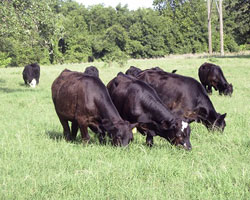Ultra-high density grazing is topic of March 29 webinar
Educational opportunity for livestock producers is free Released: March 17, 2016
Released: March 17, 2016
MANHATTAN, Kan. – Ultra-high stock density grazing is the management tool of grazing livestock in much higher-than-normal concentrations to achieve landscape-focused objectives. The long-term goal is to enhance soils, forages and livestock production.
Such grazing is usually expressed in pounds of live-weight per acre at a given moment in time. Depending on the environment and forages, ultra-high stock densities are usually in excess of 100,000 pounds of animal live-weight per acre with some graziers exceeding 1 million pounds per acre thus requiring multiple moves to fresh pasture daily.
Great Plains Grazing team member and Samuel Roberts Noble Foundation consultant, Hugh Aljoe, will present “Ultra-High Stock Density Grazing: 5 Precautions Before Implementation,” a free webinar at 1:30 p.m. (CDT) on Tuesday, March 29. The webinar is open to anyone interested in gaining a better understanding of a practice known as “mob grazing.” It is hosted by Great Plains Grazing, a U.S. Department of Agriculture-Agriculture and Food Research Initiative-Coordinated Agricultural Project (USDA-AFRI-CAP) grant.
Webinar participants can expect to learn:
- infrastructure needs;
- setting production goals and measuring them; and
- differences between stocking density and grazing intensity.
Aljoe serves as a pasture and range consultant in the foundation’s agricultural division consultation program. He serves as the consultation program manager, coordinating the efforts of the division's agricultural consultants across its 47-county service area, in both Oklahoma and Texas.
Before joining the Noble Foundation in 1995, Aljoe was the ranch manager of Belvedere Land & Cattle Corp. for 10 years. He supervised the growth of the ranch from a small 450-acre, 150-head purebred ranch into an extensive 3,900-acre, 1,500-head purebred and commercial cow-calf operation. Forage resources were predominantly introduced bermudagrass pastures (overseeded to ryegrass) that were operated in modified short-duration grazing systems.
This webinar is part of a monthly series hosted by Great Plains Grazing. The webinar series aims to provide research-based information, and is targeted for producers and extension agents. Previous webinars are archived and available for viewing on the Great Plains Grazing website.
Due to Zoom’s space limitations, this webinar is only available to the first 100 participants.
Register at Great Plains Grazing March Webinar Registration.
-30-
K‑State Research and Extension is a short name for the Kansas State University Agricultural Experiment Station and Cooperative Extension Service, a program designed to generate and distribute useful knowledge for the well‑being of Kansans. Supported by county, state, federal and private funds, the program has county Extension offices, experiment fields, area Extension offices and regional research centers statewide. Its headquarters is on the K‑State campus in Manhattan.
K-State Research and Extension
http://www.ksre.k-state.edu/
For more information:
Lana Barkman – lanaann@ksu.edu or 785-532-3354
